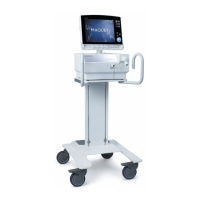
Do you have a question about the Getinge Maquet SERVO-s and is the answer not in the manual?
Provides general information about the SERVO-s Ventilator System and its components, including intended use and user.
Details warnings, cautions, important notes, and disclaimers related to the SERVO-s Ventilator System's operation and servicing.
Specifies the manual's applicability to version 8.0 and outlines patient range and system configurations.
Describes the main ventilator unit, its settings adjustment, gas supply, and securing mechanisms.
Details the components, connections, labels, and symbols of the user interface for operation.
Explains how to use the touch screen, main rotary dial, fixed keys, and direct access knobs for settings.
Illustrates and labels the connections, components, and symbols of the patient unit.
Provides instructions for safely transporting the ventilator within and between hospitals, and for storage.
Details the automatic AC power supply range selection and battery backup capabilities.
Explains how to check the estimated remaining battery time and interpret battery status indicators.
Covers status messages and warnings related to battery status and AC power failure.
Describes how to view measured and calculated breathing parameters on the screen.
Explains how to view, hide, adjust scale, and set sweep speed for waveforms.
Details how to access the event log for recorded events and view graphical representation of data.
Describes how to display trend values, adjust time resolution, and use the cursor for analysis.
Overview of different ventilation modes, settings, and associated safety information.
Defines key terms and parameters visualized in waveforms, related to flow, pressure, and volume.
Details settings like trigger sensitivity, inspiratory rise time, PEEP, I:E ratio, and end inspiration.
Explains the functional description, parameters, and alternative flow patterns for Volume Control mode.
Describes Pressure Control mode, its parameters, and how it ensures constant inspiratory pressure.
Details the PRVC mode, which adjusts inspiratory pressure to deliver preset volumes.
Explains Pressure Support mode where the ventilator supports patient breathing with set pressure.
Describes spontaneous breathing (CPAP) and Continuous Positive Airway Pressure modes.
Details SIMV modes, mandatory breaths, and spontaneous breathing between them.
Explains Bi-Vent and APRV modes, which are pressure-limited and allow spontaneous breathing.
Covers NIV usage, warnings, and settings for nasal, face, or full-face masks.
Explains how backup ventilation functions and how to disable it.
Provides a comprehensive list and definition of all ventilatory parameters and their associated symbols.
Describes special functions like Start breath, O2 breaths, Expiratory hold, and Inspiratory hold.
Outlines the overall operating procedure and details the critical pre-use check steps.
Explains how to perform a patient circuit test to evaluate leakage, compliance, and resistance.
Guides users on how to enter and edit patient-specific information for ventilation.
Describes how to select between invasive and non-invasive ventilation and set the ventilation mode.
Details how to set and adjust alarm limits, including the Autoset feature.
Provides instructions for starting invasive and non-invasive ventilation and stopping it.
Explains how to adjust additional settings and use the suctioning support function.
Covers re-adjusting the O2 cell and procedures for disconnecting the patient.
Explains the alarm system's purpose and types of warnings, and essential safety precautions.
Details how to view, silence, reset, and respond to different types of alarms.
Lists alarm settings, default values, and conditions that lead to default alarm settings.
Defines applied parts and provides important recommendations for using accessories.
Discusses the use and benefits of active humidifiers, including specific models and warnings.
Covers the purpose and precautions for using nebulizers with the ventilator system.
Describes the Compressor Mini for providing pressurized air without a central gas supply.
Introduces the chapter on alarms and error messages, suggesting response actions.
Lists high priority alarms, their possible causes, and recommended remedies.
Lists medium priority alarms, their possible causes, and recommended remedies.
Details low priority alarms and technical error messages with their causes and remedies.
Explains how to access, edit, and change the type of ventilation in the start-up configuration.
Guides on accessing the start-up configuration via the Biomed menu and editing settings.
Details the procedure for activating and using the MCare Remote Service function.
Provides system standards, EMC, patient range, IP classification, operating, and non-operating conditions.
Details power supply ranges, battery backup, external DC input, and power consumption.
Covers ventilator dimensions, weight, triggering method, and gas supply quality and levels.
Outlines specifications for the patient circuit, inspiratory, and expiratory channels.
Lists monitoring parameters like Tidal Volume, Minute Volume, O2 concentration, and their response times.
Tabulates default values and allowed setting ranges for various breathing parameters.
Specifies alarm limits for parameters, including audio off options and autoset functionality.
Details maximum inspiration time and NIV disconnect function settings.
Covers service requirements, accessory specifications, and pollution control information.
Provides information required by ISO 80601-2-12 for breath types and UDI label details.
Describes fixed keys like Audio Pause, Alarm Profile, and Trends.
Explains special function keys such as Start breaths, O2 breaths, Exp. hold, and Insp. hold.
Details functions accessible via the Quick access key, including Suction Support and Loops.
Explains the function of the Main screen fixed key for returning to the main interface.
Describes options available through the Menu key, including Alarm profile, History, and Review.
Details access to Biomed menus in standby mode for logs, configuration, and settings.
Explains screen touchpads for modes, patient data, status, and additional settings.